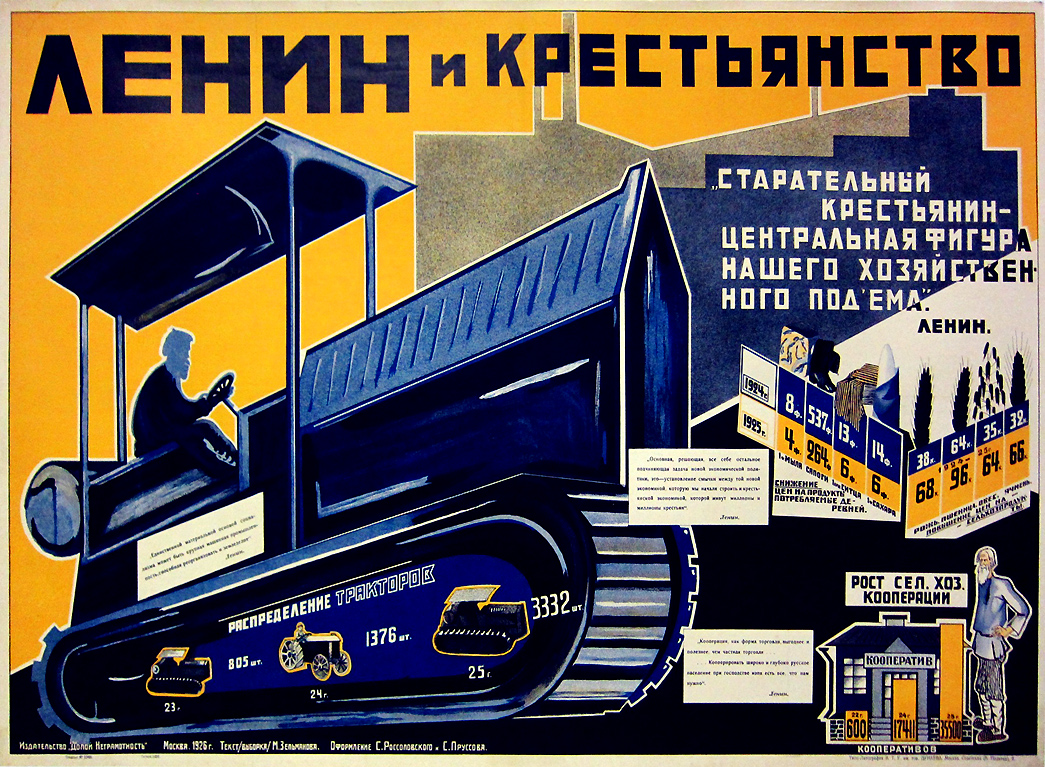
Lenin and the Peasantry. “The industrious peasant is a central figure in our economic development.” – Lenin [Partial translation]
Poster Number: PP 861
Category: Economy
Poster Notes: Poster was published by Doloi Negramotnost’ (Down with Illiteracy) under the auspices of Narkompros (People’s Commissariat for Education). In June 1920, the Sovnarkom of the RSFSR established the All-Russian Extraordinary Commission for the Liquidation of Illiteracy. From this Commission was formed the Doloi Negramotnost’ (Down with Illiteracy) campaign to teach the population to read in their native languages.
Media Size: Please inquire
Poster Type: Lithograph
Publishing Date: 1926
Editorial Information: Text/selection: M. Zel’manov; Formatting S. Rossolovskii and S. Prussov
Print Run: 5,000
Glavlit Directory Number: 53461
Sources & Citation: Baburina, N. I. (1988). Russkij plakat: vtoraa polovina XIX - nacalo XX veka. Leningrad: Hudoznik RSFSR; Russian S.F.S.R., Sokolov, A. K., & Borisova, L.V. (2000). Protokoly Prezidiuma Vysshego Soveta Narodnogo Khoziaistva. 1920: sbornik dokumentov. Moskva, Rosspen.
Catalog Notes: PP 861 Economy b
Artist: Artist Unknown — неизвестный художник
The artist's name on the poster is not indicated. By assigning Artist Unknown to a poster it also could mean the artist used a chop mark whereby no signature is seen thus rendering the artist's identity anonymous.
Read More About This Artist
Printer: Typolithography of Geokartprom of the V.T.U. (Military Topographic Directorate of the Soviet Army), Moscow — Типо-Литография Геокартпрома В.Т.У. (Военно-топографическое управление), Москва
In 1918, the Soviets nationalized the Moscow printing works of brothers Wilhelm Theodor Mehnert and Herman Julius Mehnert at 9 Bol'shaia Polianka (later named Soviet Street). The building housing the printer was first occupied by the Julius Kirsten printing firm. Upon its nationalization, the Soviets placed Mehnert printing under Geokartprom, a State-owed trust of the Commissariat of Defense that centralized government-mapping projects. Geokartprom printed atlases and maps solely for military and government use. While it did map ...
Read More About This Printer
Publisher: Narkompros (People’s Commissariat for Education) — Наркомпрос
The People's Commissariat for Education (Narkompros) was formed in 1918 and it encompassed the former Imperial Ministry of Public Education, the State Education Committee, and the former Palace Ministry (an entity that managed theaters, the Academy of Arts and the royal palaces). Overseeing Narkompros was the All-Russian Central Executive Committee (VTsIK). As the main educational branch of the government, Narkompros carried out a compliment of programs such as the combating of illiteracy, professional education, adult education, ...
Read More About This Publisher